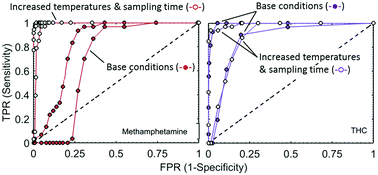Ion mobility spectrometry nuisance alarm threshold analysis for illicit narcotics based on environmental background and a ROC-curve approach†‡
Abstract
The discriminative potential of an ion mobility spectrometer (IMS) for trace detection of illicit narcotics relative to environmental background was investigated with a receiver operating characteristic (ROC) curve framework. The IMS response of cocaine, heroin, methamphetamine, 3,4-methylenedioxymethamphetamine (MDMA), and Δ9-tetrahydro-cannabinol (THC) was evaluated against environmental background levels derived from the screening of incoming delivery vehicles at a federal facility. Over 20 000 samples were collected over a multiyear period under two distinct sets of instrument operating conditions, a baseline mode and an increased desorption/drift tube temperature and sampling time mode. ROC curves provided a quantifiable representation of the interplay between sensitivity (true positive rate, TPR) and specificity (1 – false positive rate, FPR). A TPR of 90% and minimized FPR were targeted as the detection limits of IMS for the selected narcotics. MDMA, THC, and cocaine demonstrated single nanogram sensitivity at 90% TPR and <10% FPR, with improvements to both MDMA and cocaine in the elevated temperature/increased sampling mode. Detection limits in the tens of nanograms with poor specificity (FPR ≈ 20%) were observed for methamphetamine and heroin under baseline conditions. However, elevating the temperature reduced the background in the methamphetamine window, drastically improving its response (90% TPR and 3.8% FPR at 1 ng). On the contrary, the altered mode conditions increased the level of background for THC and heroin, partially offsetting observed enhancements to desorption. The presented framework demonstrated the significant effect environmental background distributions have on sensitivity and specificity.



 Please wait while we load your content...
Please wait while we load your content...